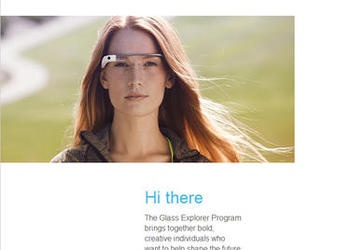Google Glass and Studying the Bible

Is there any use for a pair of wearable electronic glasses in church or in your personal Bible study?
As the Internet manager for the United Church of God, I am always looking for ways technology could be used to study the Bible and enhance that learning experience. Earlier this year, Google introduced their optical head-mounted display device called “Glass.” It allows the wearer to take photos and videos, connect to their personal Google+ account and interact with the Internet via voice commands. This week I received an email invitation to become part of Google’s Glass Explorer program.
This got me thinking on how a wearable device like this could be used to study the Bible and what possibilities it could have in a church service or worship setting. Wearable computer devices are not new and have been available but they have not been widely accepted and functionable in daily life. That may change with devices like Google Glass and other wearable Internet connected devices.
Here are three ideas on how something like Google Glass could be used to enhance Bible learning:
1. Scripture recognition
Since Glass has a built in camera it could recognize various word patterns in the real-world and translate that information to its display screen. Imagine being able to scan words in your physical Bible and have it display various other Bible related resources to view. This could be definitions, translations, images, videos, audio and more. Maybe a popular Bible app such as YouVersion could open in the display and connect you to other Bible translations or read the verse to you. This type of application already exists in Glass to help in realtime translation of words from one language to another.
2. Visit Biblical and historical locations
Maybe you can access an interactive video that allows you to walk through Jerusalem and immerse yourself in that location and visit historical landmarks. With the use of augmented reality you can blend a real-world visit to a museum featuring Biblical artifacts with interactive information from the web. Just point your device’s camera toward the displayed QR code and the display screen shows relevant information or plays audio about what you are looking at.
3. Online Bible classroom setting
While taking an online class, a Biblical instructor in Jerusalem can give a personal tour of ancient sites via a live video feed and show the online class what they see and take questions from the class. This can already be done via a Google Hangout.
I believe there are many more day-to-day ease of technology use applications that could be developed which would assist those with mobility limitations or even sight limitations (read the online article from USA TODAY - "Beyond a gadget: Google Glass is a boon to disabled"). I would guess that in the next 5 to 10 years or even less, that wearable Internet devices will be more common and integrated into daily life somehow. Technology like this will become the everyday device for my kids when they are adults - as much as smartphones and tablets are for us today.
This makes me think of scripture in Revelation 11 that talks about how the whole world will see the bodies of the two witnesses:
And for three and a half days, all peoples, tribes, languages, and nations will stare at their bodies. No one will be allowed to bury them. (Revelation 11:9 NLT)
With every advance of technology we can see how this future Biblical event will become a reality.
But till that time, I will keep searching (as well as our UCG.org staff) in how to best use technology to fulfill the mission of the United Church of God of preaching the gospel to the whole world.
If you are curious about Google Glass and would like to learn more - here are some online resources.
